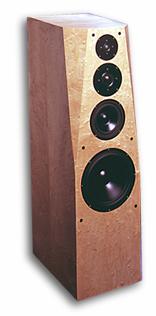![[SoundStage!]](../titles/sslogo3.gif) Home
Audio Home
Audio Equipment Review |
||
May 2000 Silverline Audio Sonata Loudspeakers by Marc Mickelson
Well, now it's the Sonata's turn in the spotlight, and I find I have little to say about it that I haven't already said about the Sonatina. The first thing you notice is their good looks, and the pair I had, in birdseye maple, was not even the most lovely of the finishes (this distinction would go to briarwood). This didn't stop one of my non-audiophile friends from inquiring about the cost of the Sonatas when he saw them in my listening room. He thought they would compliment the floors in his living room, and he was right. I remarked in the Sonatina review that the speakers look like a model from Avalon, but what I didn't say was how different the products from these two companies are. While the Silverline speakers love tubes, especially low-powered ones, I have never heard a pair of Avalons driven by anything but beefy solid state (which is not to say it doesn't happen, only that I haven't heard it). The Silverline speakers are also considerably less expensive and offer a sound that is intrinsically different, more toward ease and civility. One thing the two speakers do share is sounding great at shows -- both companies' products were impressive at HI-FI '99 in Chicago and CES 2000. Looks and show reputation are only window dressing; of course, it's how a product functions in your room and system that matters. As I found with the Sonatinas, the Sonatas offer airy and clear treble that has no intrinsic faults of its own. As with the Sonatina, the Sonata casts a very spacious soundstage that gives more than a hint of the space in which the recording was made -- if it's on the recording, that is. The midrange takes great advantage of SET amplification to give an exceedingly clear picture of voices, which don't sound thin, instead offering fine presence and dimension. I'm a Greg Brown junkie and listened to his The Poet Game [Red House RHR CD 68] and Further In [Red House RHR CD 88] more than a couple of times when the Sonatas were in my system just to hear Brown's chesty singing. Where the Sonata veers from the sound of its smaller brother is in the bass, which is both deeper and weightier, as you would expect given its larger 10" woofer. However, where the Sonatina's bass is present but not readily noticeable, the Sonata's bass is fully accounted for when the recording has the bottom end to display. This can be a good thing if your amp controls the bass fairly well or a bad thing if your amp is all loosey goosey down low. Lower-output tube amps, especially triodes, can be a bit overly ripe in the bass, and the Sonata's big woofer will not be kind. I often wondered about bi-amping the speakers to tighten up their bass when it was needed, but then the Lamm monoblocks I use most of the time don't cause any problems with the Sonatas, so I didn't experiment. You may want to if you find, as I said in my review of the Sonatina, that you'd like the Sonata's bass "to have a little less play." As I've indicated, there are many reasons to like the Silverline Sonatina and Sonata. In the end, given the similarities of the two speakers, the person who should consider the Sonata is someone who likes the Sonatina but wants deeper and weightier bass because this is essentially what the larger speaker offers. In my Sonatina review, I mentioned that experimentation with a subwoofer was not recommended because of worry for what might happen to the overall sound produced if integration weren't just right. The Sonata, however, gives you some or even most of what a subwoofer would offer and retains the good things about the Silverline sound. If you are interested in either Silverline model, I would strongly suggest listening to both. You may find that the added low-end response of the Sonata is irresistible or that you can live with what the Sonatina offers -- as I could. Both speakers are worthy of your consideration if you're a tubehead and music lover. ...Marc Mickelson
|
||
|
||
![[SoundStage!]](../titles/sslogo3.gif) All
Contents All
ContentsCopyright © 2000 SoundStage! All Rights Reserved |
